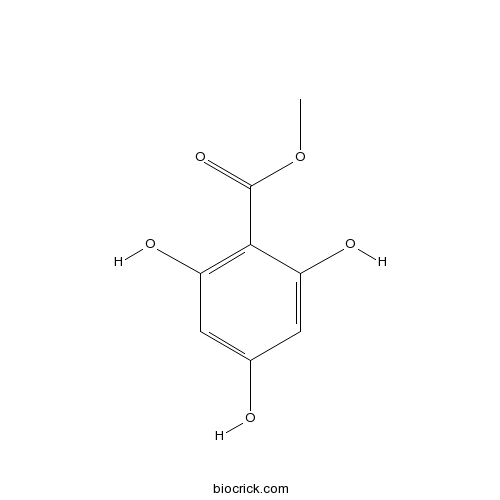Methyl 2,4,6-trihydroxybenzoateCAS# 3147-39-5 |

Quality Control & MSDS
3D structure
Package In Stock
Number of papers citing our products

| Cas No. | 3147-39-5 | SDF | Download SDF |
| PubChem ID | 76600 | Appearance | Powder |
| Formula | C8H8O5 | M.Wt | 184.15 |
| Type of Compound | Phenols | Storage | Desiccate at -20°C |
| Solubility | Soluble in Chloroform,Dichloromethane,Ethyl Acetate,DMSO,Acetone,etc. | ||
| Chemical Name | methyl 2,4,6-trihydroxybenzoate | ||
| SMILES | COC(=O)C1=C(C=C(C=C1O)O)O | ||
| Standard InChIKey | AQDIJIAUYXOCGX-UHFFFAOYSA-N | ||
| Standard InChI | InChI=1S/C8H8O5/c1-13-8(12)7-5(10)2-4(9)3-6(7)11/h2-3,9-11H,1H3 | ||
| General tips | For obtaining a higher solubility , please warm the tube at 37 ℃ and shake it in the ultrasonic bath for a while.Stock solution can be stored below -20℃ for several months. We recommend that you prepare and use the solution on the same day. However, if the test schedule requires, the stock solutions can be prepared in advance, and the stock solution must be sealed and stored below -20℃. In general, the stock solution can be kept for several months. Before use, we recommend that you leave the vial at room temperature for at least an hour before opening it. |
||
| About Packaging | 1. The packaging of the product may be reversed during transportation, cause the high purity compounds to adhere to the neck or cap of the vial.Take the vail out of its packaging and shake gently until the compounds fall to the bottom of the vial. 2. For liquid products, please centrifuge at 500xg to gather the liquid to the bottom of the vial. 3. Try to avoid loss or contamination during the experiment. |
||
| Shipping Condition | Packaging according to customer requirements(5mg, 10mg, 20mg and more). Ship via FedEx, DHL, UPS, EMS or other couriers with RT, or blue ice upon request. | ||

Methyl 2,4,6-trihydroxybenzoate Dilution Calculator

Methyl 2,4,6-trihydroxybenzoate Molarity Calculator
| 1 mg | 5 mg | 10 mg | 20 mg | 25 mg | |
| 1 mM | 5.4304 mL | 27.1518 mL | 54.3036 mL | 108.6071 mL | 135.7589 mL |
| 5 mM | 1.0861 mL | 5.4304 mL | 10.8607 mL | 21.7214 mL | 27.1518 mL |
| 10 mM | 0.543 mL | 2.7152 mL | 5.4304 mL | 10.8607 mL | 13.5759 mL |
| 50 mM | 0.1086 mL | 0.543 mL | 1.0861 mL | 2.1721 mL | 2.7152 mL |
| 100 mM | 0.0543 mL | 0.2715 mL | 0.543 mL | 1.0861 mL | 1.3576 mL |
| * Note: If you are in the process of experiment, it's necessary to make the dilution ratios of the samples. The dilution data above is only for reference. Normally, it's can get a better solubility within lower of Concentrations. | |||||

Calcutta University

University of Minnesota

University of Maryland School of Medicine

University of Illinois at Chicago

The Ohio State University

University of Zurich

Harvard University

Colorado State University

Auburn University

Yale University

Worcester Polytechnic Institute

Washington State University

Stanford University

University of Leipzig

Universidade da Beira Interior

The Institute of Cancer Research

Heidelberg University

University of Amsterdam

University of Auckland

TsingHua University

The University of Michigan

Miami University

DRURY University

Jilin University

Fudan University

Wuhan University

Sun Yat-sen University

Universite de Paris

Deemed University

Auckland University

The University of Tokyo

Korea University
- cis-Shegansu B
Catalog No.:BCN9428
CAS No.:865474-99-3
- 3-epi-Dihydroscandenolide
Catalog No.:BCN9427
CAS No.:1137951-08-6
- Lipoaconitine
Catalog No.:BCN9426
CAS No.:81941-14-2
- Lipodeoxyaconitine
Catalog No.:BCN9425
CAS No.:244190-83-8
- Minisecolide D
Catalog No.:BCN9424
CAS No.:1967030-78-9
- 3-(Hydroxyacetyl)indole
Catalog No.:BCN9423
CAS No.:2400-51-3
- 4-Hydroxyxanthone
Catalog No.:BCN9422
CAS No.:14686-63-6
- Macluraxanthone
Catalog No.:BCN9421
CAS No.:5848-14-6
- Deoxymikanolide
Catalog No.:BCN9420
CAS No.:23753-57-3
- 4,5-Dihydropiperlonguminine
Catalog No.:BCN9419
CAS No.:23512-53-0
- Dihydromikanolide
Catalog No.:BCN9418
CAS No.:23758-04-5
- 2,6-Dihydroxyxanthone
Catalog No.:BCN9417
CAS No.:838-11-9
- Elatoside E
Catalog No.:BCN9430
CAS No.:156980-30-2
- 1H-Indole-3-carbaldehyde
Catalog No.:BCN9431
CAS No.:487-89-8
- Scandenolide
Catalog No.:BCN9432
CAS No.:23758-16-9
- Neoorthosiphol A
Catalog No.:BCN9433
CAS No.:243448-72-8
- Orthosiphol B
Catalog No.:BCN9434
CAS No.:144078-08-0
- Physaminimin N
Catalog No.:BCN9435
CAS No.:2131235-87-3
- [4]-Gingerdiol
Catalog No.:BCN9436
CAS No.:53254-75-4
- Cucurbitacin IIa 2-O-glucoside
Catalog No.:BCN9437
CAS No.:77704-34-8
- 1,5-Epoxy-3-hydroxy-1-(3,4-dihydroxy-5-methoxyphenyl)-7-(4-hydroxy-3-methoxyphenyl)heptane
Catalog No.:BCN9438
CAS No.:182227-93-6
- 1-Oxohederagenin
Catalog No.:BCN9439
CAS No.:618390-67-3
- ent-Toddalolactone
Catalog No.:BCN9440
CAS No.:1570054-19-1
- Withaphysalin C
Catalog No.:BCN9441
CAS No.:57485-60-6
Biocatalytic Properties and Structural Analysis of Phloroglucinol Reductases.[Pubmed:27874239]
Angew Chem Int Ed Engl. 2016 Dec 12;55(50):15531-15534.
Phloroglucinol reductases (PGRs) are involved in anaerobic degradation in bacteria, in which they catalyze the dearomatization of phloroglucinol into dihydrophloroglucinol. We identified three PGRs, from different bacterial species, that are members of the family of NAD(P)H-dependent short-chain dehydrogenases/reductases (SDRs). In addition to catalyzing the reduction of the physiological substrate, the three enzymes exhibit activity towards 2,4,6-trihydroxybenzaldehyde, 2,4,6-trihydroxyacetophenone, and Methyl 2,4,6-trihydroxybenzoate. Structural elucidation of PGRcl and comparison to known SDRs revealed a high degree of conservation. Several amino acid positions were identified as being conserved within the PGR subfamily and might be involved in substrate differentiation. The results enable the enzymatic dearomatization of monoaromatic phenol derivatives and provide insight into the functional diversity that may be found in families of enzymes displaying a high degree of structural homology.


